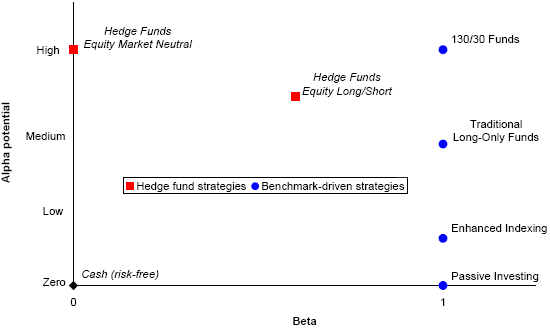Should investors shift from traditional long-only mutual funds to newer and more flexible 130/30 (130% long/30% short) equity funds? In other words, does the flexibility of 130/30 funds to short stocks and expand portfolios enhance returns? In the May 2008 version of his paper entitled “130/30 Investing: Just Another Hype or Here to Stay?”, David Blitz enumerates theoretical advantages and disadvantages of 130/30 investing and discusses ways in which 130/30 fund managers are implementing their flexibility, concluding that:
- 130/30 equity funds are more like traditional mutual funds (measured to a benchmark) than hedge funds (measured to absolute return). See the figure below.
- A 130/30 approach potentially offers three advantages by allowing the fund manager to:
- Exploit negative information about stocks by shorting, as well as positive information about stocks by buying.
- Weight stocks more flexibly within an expanded set of long holdings.
- Increase diversification via an expanded set of long and short holdings.
- The validity of the first two of these three advantages depends on the ability of fund managers to generate alpha from both long and short positions, an ability perhaps better derived from quantitative than fundamental analysis.
- Expenses for 130/30 funds tend to be higher than expenses for comparable long-only funds because of:
- Added trading fees, funding burden and administrative costs involved in shorting.
- Increased transaction costs for an expanded portfolio.
- Greater effort in managing a more complex portfolio (to take more alpha from others) and therefore usually higher fees.
- 130/30 equity funds implemented piece-wise (such as a 100% long portfolio augmented by a 30% market neutral portfolio) sacrifice some of the efficiency offered by an integrated portfolio construction approach.
- Parameter-driven 130/30 fund benchmarking is problematic due to arbitrariness in selecting parameter values.
The following chart, taken from the paper (via Robeco Quantitative Strategies), illustrates the conceptual alpha/beta position of 130/30 funds relative to other investment strategies. 130/30 funds have more alpha-generating opportunities than traditional long-only funds, with comparable exposure to the movement of the overall equity market.

In summary, investors who believe that they can find fund managers who reliably generate alpha should consider the enhanced alpha for higher fee trade-off of 130/30 funds.